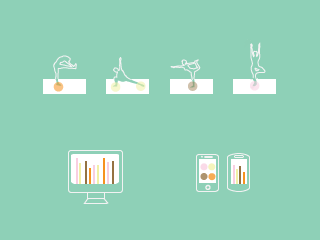Smart Mat
Hiye Shin
Smart Mat lets you track your yoga practice in a new way. By tracking the changes in your body's balance, Smart Mat shows you the patterns of your movement and flow and offers focused feedback that helps you improve your yoga practice.

Smart Mat uses force–resistance sensors built into a yoga mat to measure the distribution of your body weight as you move through the balance poses of your yoga practice. These four sensors enable you to keep track of your posture while giving you optional real-time feedback on the symmetry of your pose. The Smart Mat application gives you on-the-spot auditory feedback, provides a visual summary of your practice, and tracks your improvements over time. Your regular practice does not need to change in any way. Smart Mat is as transparent as you want it to be. Your downward dog will be more balanced than ever!
Background
Market Research: After research of yoga-related products, I made a conclusion that there is no digital product mainly focusing on practice itself and has more than just a game aspect.
Product Research: Since ancient India, people have been used various materials to place on the floor. Current version of yoga mat invented in 1982 and started to produce in market around 1990. (source: wikipedia)
Scientific Research: I tried to find medical journal that has a scientific analysis on yoga, but surprisingly it seems to be not easy to measure.
User Research: I conducted user interviews, and visited two different yoga studios and a yoga good store to meet people who actually uses the product. Majority of them has their personal yoga mat for practicing.
Trend Research: Following with current 'big data' trend, I am expecting this 'quantification of yoga movement' has a potential of being used to more than just dedicated yogi.
Audience
Anybody who enjoys using digital products to modify their healthy lifestyle in more active way.
Implementation
User experience design was the most critical part in my production process. Although I started with this project to solve the problem that I have been encountering while my yoga practice, I did not want to sacrifice the whole practice experience under the name of technology. That means, I didn't want to use computer vision because many people outside of tech world gave me a feedback that it may be feel awkward to do yoga every time in front of camera. I once considered wearable technology too, but eventually decided to not use that idea because it could be very impractical: I never wear bulky or long–sleeve clothes when I do yoga. By opting out many options considering user experience, I back to basic of key practicing item 'mat' and (probably) most convenient item to carry around: smart phone that can access to web browser.
Conclusion
People's feedback was same: "When I can see your yoga mat?" That was something that I really wanted to answer. People liked the idea, but skeptical about the accuracy of the data that I am aiming to get. I may not achieve to find the perfect answer by myself within one semester, but I still do think there is potential in this project. What I learned: Design aspect: digital product production workflow Technology: Django, Twisted, Autobahn Hardware: Linux computer setup, choosing proper materials for building custom sensors
Background
Market Research: After research of yoga-related products, I made a conclusion that there is no digital product mainly focusing on practice itself and has more than just a game aspect.
Product Research: Since ancient India, people have been used various materials to place on the floor. Current version of yoga mat invented in 1982 and started to produce in market around 1990. (source: wikipedia)
Scientific Research: I tried to find medical journal that has a scientific analysis on yoga, but surprisingly it seems to be not easy to measure.
User Research: I conducted user interviews, and visited two different yoga studios and a yoga good store to meet people who actually uses the product. Majority of them has their personal yoga mat for practicing.
Trend Research: Following with current 'big data' trend, I am expecting this 'quantification of yoga movement' has a potential of being used to more than just dedicated yogi.
Audience
Anybody who enjoys using digital products to modify their healthy lifestyle in more active way.
Implementation
User experience design was the most critical part in my production process. Although I started with this project to solve the problem that I have been encountering while my yoga practice, I did not want to sacrifice the whole practice experience under the name of technology. That means, I didn't want to use computer vision because many people outside of tech world gave me a feedback that it may be feel awkward to do yoga every time in front of camera. I once considered wearable technology too, but eventually decided to not use that idea because it could be very impractical: I never wear bulky or long–sleeve clothes when I do yoga. By opting out many options considering user experience, I back to basic of key practicing item 'mat' and (probably) most convenient item to carry around: smart phone that can access to web browser.
Conclusion
People's feedback was same: "When I can see your yoga mat?" That was something that I really wanted to answer. People liked the idea, but skeptical about the accuracy of the data that I am aiming to get. I may not achieve to find the perfect answer by myself within one semester, but I still do think there is potential in this project. What I learned: Design aspect: digital product production workflow Technology: Django, Twisted, Autobahn Hardware: Linux computer setup, choosing proper materials for building custom sensors


